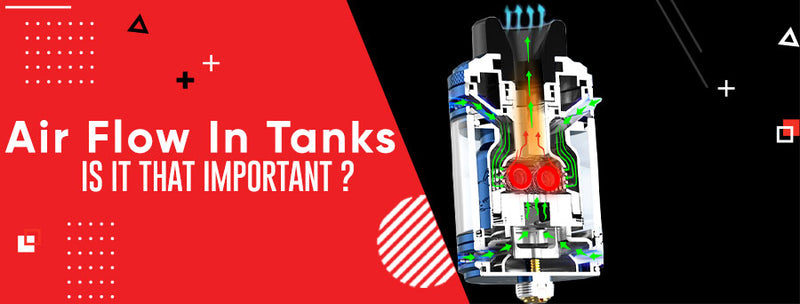You might prefer to keep your vapour discreet when vaping. Or maybe you want to create clouds like a fog machine. You may be an ex-smoker who appreciates the familiar sensation of a throat hit, whilst others might enjoy a smooth draw.
Whatever your vaping preference, airflow is sure to play a role whether you realise it or not.
We'll discuss the role of airflow in vape tanks and its impact on the overall vaping experience. Vape tanks with an adjustable airflow allow vapers to really fine-tune their experience and discover their own personal sweet spot.
Finding the right airflow that works for you can transform the way you vape, from adding layers of flavour, changing the amount of vapour you exhale, and protecting your coils and wicks. Understanding airflow is a breeze. Let's flow with it...
How do vape tanks work?
Vape tanks work by heating a quantity of vape juice with a coil typically made of a resistant metal wire wrapped around a wicking material, most often made of cotton.
Vape juice soaks into the cotton which is then heated up when the fire button is pressed. As the vape juice is heated, it turns into vapour. This vapour is drawn up through the tank's chimney and mouthpiece when the vaper takes a hit.
The airflow together with the coil, wicking material, and vape juice quality are all elements that contribute to the overall sensation and quality of the draw.
Airflow explained
Many vape tanks come with adjustable airflow control mechanisms. These allow you to regulate the amount of air that flows over the coil as you inhale. Adjusting the airflow affects the vapour temperature, density, and overall vaping experience.
In broad terms here is how airflow effects vaping:
- Increased airflow – slightly lower flavour and less chance of a harsh throat hit with greater vapour and a cooler cloud.
- Decreased airflow – more flavour and intensity with lower and warmer cloud production.
How airflow impacts flavour
Airflow is but one factor that impacts flavour. There are a bunch of factors that play an important part too such as wattage and coil resistance and vaping styles (but more on this later). With this being said, adjusting the airflow can completely transform your experience:
- With greater airflow, the vapour contains less concentrated flavour compounds. This potentially makes the flavour less intense. Cooler vapour is associated with less pronounced flavours.
- With decreased airflow, the vapour is more concentrated, enhancing the flavour and taste. It is also warmer which delivers richer flavour notes.
How airflow impacts vapour temperature
Adjusting the airflow on a vape device affects the concentration and temperature of the vapour generated.
With more airflow, the vapour is diluted, and a smoother and cooler cloud results. Increased airflow cools down the vapour as it travels from the coil to the mouthpiece. The more air that mixes with the vapour, the cooler the resulting vapour will be when it reaches your mouth and lungs.
This can be compared to blowing on a hot drink to cool it down – the increased airflow lowers the temperature.
On the other hand, less air supports a denser, warmer cloud.
Matching airflow with your coil resistance and type
Matching airflow with your vape coil and its resistance involves selecting an airflow setting that complements the coil's power requirements and your vaping style. The goal is to maintain the coil's temperature while achieving your desired flavour and cloud levels.
Depending on the coil’s resistance, it might be able to be used with high-powered devices or it may require low wattages in order to achieve the coil’s optimum performance.
By paying attention to how much air passes through your vape you can avoid the unpleasant consequences of a dry wick, burnt coil, and the nasty lingering edge of burnt hits.
- Let's talk sub-ohm coils. These low resistance (below 1 ohm) coils are often used for direct-to-lung (DTL) vaping and require higher wattages to produce vapour effectively. They are designed for intense flavour and can build immense clouds.
With low-resistance coils, you generally need more airflow to prevent the coil from overheating and to ensure efficient vapourisation so that the vapour can be comfortably inhaled into your lungs. - Mouth-to-lung (MTL) coils have higher resistance, and are often preferred by ex-smokers or beginner vapers. These coils work well at lower wattages and provide a more restricted airflow. MTL coils are typically matched with tighter airflow settings to create a similar experience to traditional smoking. A narrow airflow can help contribute to the flavour and throat hit in MTL setups.
Customising your vape with adjustable airflow
Adjustable airflow functionality allows you to select an airflow that results in either a tighter or looser vape, a warmer or cooler cloud, a range of flavours, and more besides.
Airflow is the easiest variable to adjust and customise. Whether you're cloud chasing, savouring a creamy dessert flavour or looking for more of a throat hit as you inhale, a good tip is to first button down the other aspects that influence the vape - such as the wattage, the VG/PG of your vape juice, preferred vape mode, and coil resistance.
It’s best to start tweaking the airflow once everything else is good to go.
Direct-to-lung (DTL) vs. mouth-to-lung (MTL) vs. restricted-direct-lung (RDL) airflow
Depending on the type of vape kit you have, it might be best suited to certain types of vaping styles, and thus, certain types of airflow. Let’s take a look at the different vaping styles and how airflow contributes to the cooling and heating effects of vapour:
- With DTL (Direct-to-Lung) vaping inhaling vapour directly into your lungs. DTL vaping favours good airflow and provides a more intense and flavourful experience due to the increased flow and vapour. Be careful not to set your airflow too high because cooling vapour can thin your flavours.
- With MTL (Mouth-to-Lung) vaping you are first drawing the vapour into the mouth and then into the lungs. It typically requires lower wattages and higher resistance coils. Since you're not cloud chasing with MTL vaping, you don’t need to worry about opening up the airflow too much. It's usually best to keep your airflow setting toward the low end here.
- Restricted-Direct-Lung (RDL) is a style that falls between DTL and MTL. It involves a looser draw than MTL but isn't as wide or generous as DTL. Here it’s all about finding a happy balance. Adjusting your airflow collar will help you find that sweet medium cool!
Conclusion
The significance of airflow in vape tanks cannot be overstated. Whether you seek discreet clouds or intense flavour, airflow is pivotal in tailoring your vaping experience. Adjustable airflow options empower vapers to pinpoint their ideal setup, influencing factors like vapour temperature, density, and taste.
From enhancing flavours to safeguarding coils, mastering airflow can revolutionise your vaping journey. By harmonising airflow with coil resistance and style, whether it's DTL, MTL, or RDL, you can create a personalised vape that truly satisfies.
We offer an outstanding range of top-draw tanks geared for great performance to consistently deliver awesome flavours and the vapour levels you're looking for. Head on over to our list of the best beginner vape tanks to help you get started.
If you still have any more questions, feel free to contact us today.
FAQs
Do airflow holes cause your tank to leak?
Air holes don't cause your vape tank to leak. If your tank is leaking it's likely because it is overfilled or your coil and wick are oversaturated with vape juice.
What airflow makes a vape last longer?
Higher airflow may require less e-juice because the fresh air remains on the coils longer. However, your flavour might be diluted. You will likely get more taste from your vape with less air, but your juice is consumed faster in this scenario.
What's the best airflow setting to get big clouds?
If you're all about cloud chasing and huge vapour production then you want to go for a high setting and open all airflow holes to encourage those impressive billows of vapour.

